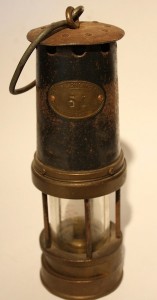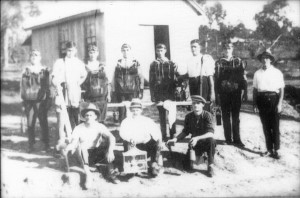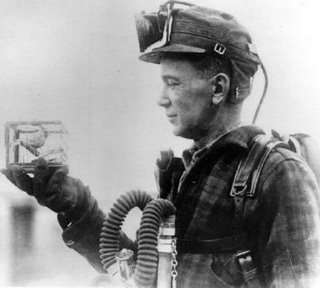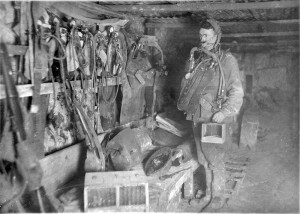1967: Collinsville Powerhouse Strike – more than 200 workers rallied outside the gates of the powerhouse for 13 weeks over a dispute in pay and allowances. ABC Four Corners documented the struggle and life in Collinsville in the late 1960s. A must watch for all current and past Collinsville locals:
News
The Davy Flame Safety Lamp

Do you know what this is?
The flame safety lamp was invented by Sir Humphrey Davy in 1815. The lamp housed a flame within a cylinder of gauze that would dissipate the heat of the flame so it would not ignite any gas present. The lamp could then be used to check for the presence of methane gas or firedamp. If the flame burned high and with a blue tinge, then methane was present. If the flame grew low or went out, the miner would know that oxygen levels were low. Unfortunately the original lamps did not give out a lot of light and many miners would remove the gauze cylinder, heightening the risk of explosion.
In Australia the Davy flame safety lamp remained in use until 1986. An explosion at Moura No.4 mine, resulting in the deaths of 12 miners, led to an Inquiry and amendments to the Coal Mining Act, including the banning of flame safety lamps underground.
Coal mining in the early 1900s… Did you know:
As the world plunged into the Industrial Revolution, coal become a highly sought after commodity for the powering of steam engines. The first coal discovered in Australia was in 1791 and by 1801 Australia’s first commercial coal mine was in operation.
At the turn of the century the safety of miners underground was the responsibility of the mine owner and the miner themselves. Safety equipment was primitive and often not used at all. It was only after several mine disasters that the Australian government began to regulate the industry and introduce safety measures. As a result of this new awareness, the first Queensland Mines Rescue Brigade was formed in 1910.

BCCM Garrick Tunnel Entrance
This is one of the most recognised historical photos of Collinsville – but do you know who the people are? The photo was taken in 1920 at the entrance to BCCM Garrick tunnel. And the people: from left – Norman Poole on Darkie, Tom Henderson, Ted Rowell, Dinny Dinsdale, Molly Gordon (girl bringing lunches), Tom Poole, Jack Poole, John McNaughton (Mine Manager) and Digger Hoffmann.
(click image to open large version in new window)
Canaries Underground
Did you know the last canary retired from service in 1980 in Queensland? While they had not been carried underground by miners for many years, they were still valued members of the Queensland Mines Rescue Service. They even played a role in tunnelling in World War 1!



Box Flat Mine Disaster approaches 41 year memorial
31st July, 1972, 3am, 10 miners and 7 rescuers were killed in an explosion at Box Flat Mine, Ipswich. Another 12 were seriously injured. 3 of the men killed were working on the surface adjacent to the mine entrance.
Mr Hardie: “I recollect a suck back of material towards the tunnel mouth followed by a huge ball of bright red flame which shot out and illuminated the area for hundreds of feet”. By the following morning bulldozers moved in to seal the mine, forever entombing 14 of the victims. A memorial service was held against the backdrop of billowing black smoke. For miners and residents the disaster is still fresh in their minds 41 years on.



